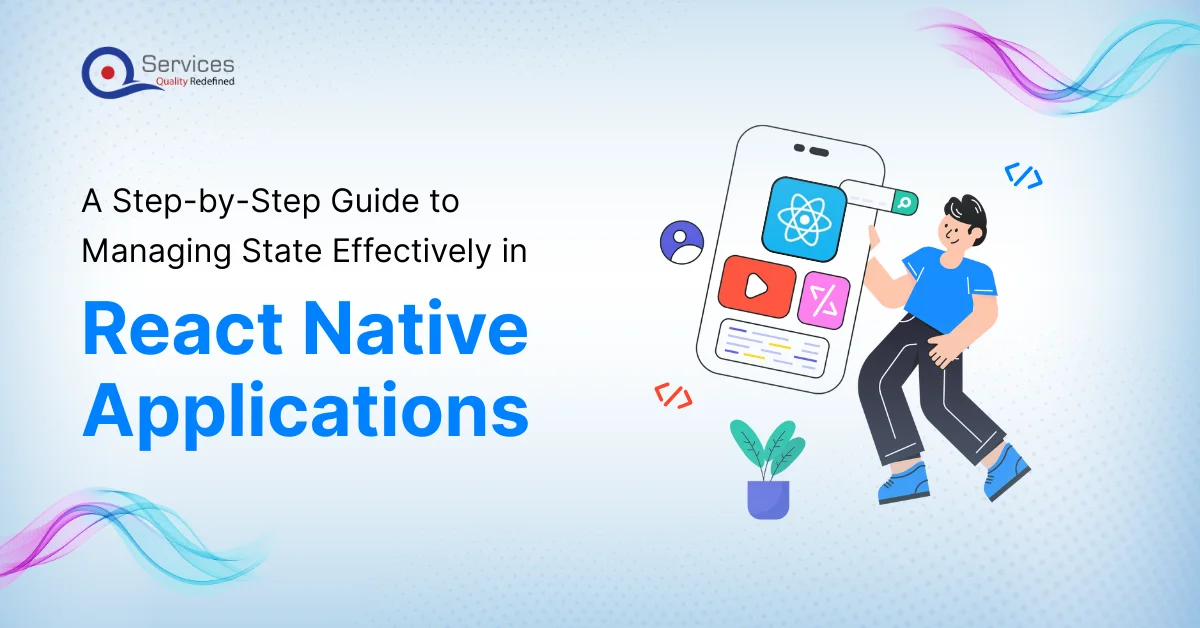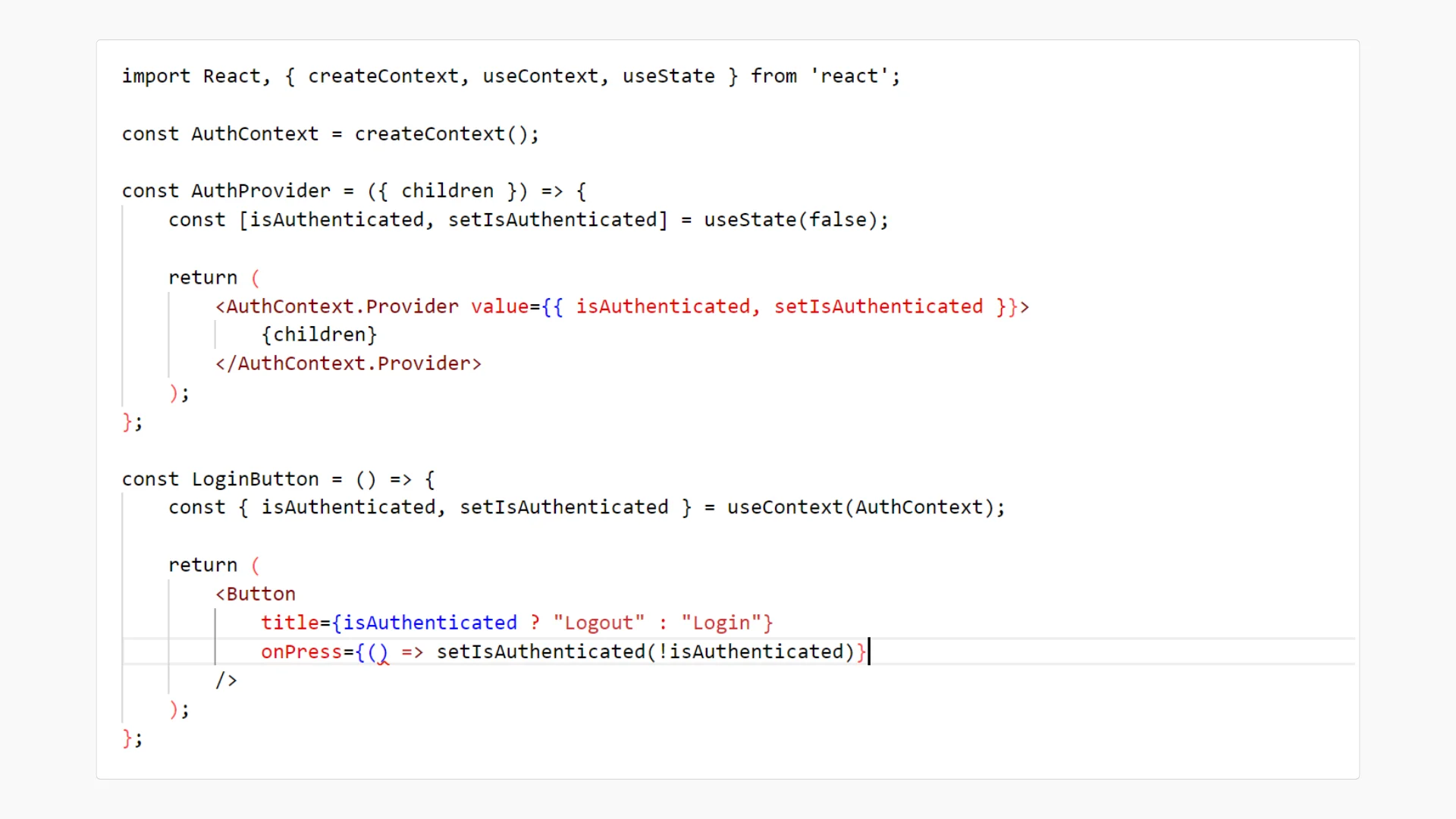
Home » A Step-by-Step Guide to Managing State Effectively in React Native Applications

State management in React Native is the handling and control of data in a mobile application. It is the dynamic data that affects the behavior and look of components, including user input, data fetched from APIs, or the state transitions. Controlling this efficiently ensures that the UI of the application stays in sync with the data underneath, creating a smooth and responsive experience.
This system gives a number of strategies and mechanisms for managing state and in order to accomplish this, utilize hooks such as useState to manage locally in individual components. It can also be handled using React Native state management libraries such as Redux or the Context API to manage globally across many components. Programmers can develop apps that are performant, scalable, maintainable, and adaptantly change to user inputs and data changes by managing suitably.
In React Native, state refers to the data that drives the UI and determines how the application behaves. State can be local (specific to a single component) or global (shared across multiple components).

Local state is used for data that only needs to exist within a single component. It can be managed using React’s useState hook, which allows you to update and store data within that component. For example:
Global state refers to data that needs to be accessed or modified across multiple components in an app. Managing global state is more complex because changes in one component can affect others. React Native provides various solutions for this, such as the Context API, Redux, and other third-party libraries.
To ensure effective performance and maintainability, optimizing state management is crucial while developing React Native applications. Developers can eliminate needless re-renders of components, lower memory usage, and improve the overall responsiveness by carefully managing it. Apart from ensuring that UI updates synchronize with data changes, efficient state management also enhances the user experience by improving load times and interaction responsiveness, resulting in a smoother experience.
This also helps maintainability and organization of code, which makes it simpler for developers to comprehend and manage their codebase as an application grows. They can build high-quality React Native apps that satisfy stakeholders and consumers alike by streamlining development workflows, minimizing potential problems, and utilizing the right tools for state management and best practices.
Get free Consultation and let us know your project idea to turn into an amazing digital product.

Effective React Native state management requires an understanding of the data flow within it. This platform uses a unidirectional data flow model in which state changes are communicated downward through component hierarchies and data flows via props from parent components to child components.
Breaking down user interfaces into smaller, reusable parts facilitates improved code organization and management. Developers can encourage code reusability and implement logic by creating components with clearly defined roles.
Maintaining responsiveness and performance depends on optimizing state management. Applications can run better and provide a better user experience by reducing the number of needless re-renders, making use of memoization techniques, and implementing asynchronous updates.

The Context API is built into React and allows you to share state globally without the need for third-party libraries. Here’s how you can use it:
Create a new context using createContext().
Use a Provider to wrap your app’s component tree, making the context available to all children.
Use the useContext hook to consume the context in any child component.

Local State: Best suited for data that doesn’t need to be shared, such as form inputs, modal visibility, etc.
Global State: Use for data that needs to be shared across multiple components, such as user authentication, global settings, etc.
In a small app, local state management (using useState and useContext) may suffice. However, for larger apps, global state management solutions like Redux are recommended for better scalability and maintainability.
When your app grows and requires more complex state logic (e.g., fetching data, managing state across multiple screens), Redux is an excellent solution. Redux is a state management library that provides a predictable state container for JavaScript apps. It works well for React Native because it provides a single source of truth (the Redux store), which makes it easier to manage and debug complex state interactions.
1. Store: Centralized storage for your app’s state.
2. Actions: Events that trigger state changes.
3. Reducers: Functions that specify how the state changes in response to actions.
Example of setting up Redux:


Overusing context or Redux for frequently changing data can lead to performance problems. Avoid excessive re-renders by using memoization techniques (e.g., React.memo, useMemo) and minimizing the number of context or Redux store updates.
Inconsistent state updates can occur if asynchronous actions are not properly handled. Use middleware like Redux Thunk or Redux Saga to handle asynchronous actions in Redux.
Deeply nested components can become difficult to manage. If you find yourself passing down props through many layers, consider using context or a global state management solution like Redux.
EXAMPLE:

Share your project idea with us. Together, we’ll transform your vision into an exceptional digital product!

Efficient state management lies at the center of creating scalable, high-performance, and manageable React Native apps. By wisely choosing the optimal state management solution, you can guarantee seamless data flow, prevent redundant re-renders, and have a neat and organized codebase. Built-in utilities of React such as useState and useContext are great for handling local and light global state, and they keep your application straightforward and streamlined. But as apps increase in sophistication, state management is better achieved through more capable solutions to avoid prop drilling, optimize performance, and ensure predictability.
For more involved projects with communicating data between different parts or pages, external libraries like Redux help adopt a system thinking with a singular source of record. TheRedux’s pattern (actions, reducers, store) for state managements based on predictability enhances debugging, scalability, and state saving in an impeccable fashion, suitable ideally for extensive programs. UseRedux sparingly and only where applicable since superfluous boilerplating increases irrelevant complexity. Others such as Zustand, Recoil, or MobX provide more light solutions, depending on your app’s requirements.
Ultimately, the key to effective state management in React Native lies in understanding the scope of your application and choosing the right tools accordingly. Using local state where possible, leveraging Context API for moderate global state needs, and integrating a scalable state management library for complex applications will help maintain a well-organized and high-performing app. By employing best practices—like minimizing excessive prop drilling, re-renders optimization, and logically designing state—you are able to construct clean, maintainable, and performing React Native applications.
You can use built-in tools like useState and useReducer, or external libraries like Redux, MobX, and Context API.
Local state is used inside a single component (like a text input field).
Global state is shared across multiple components (like user login status)
Install Redux, create a store, define actions and reducers, and connect components using react-redux.
Use useSelector to read data from the store and useDispatch to update it.
MobX is another state management tool that automatically tracks data changes. It’s simpler than Redux because it has less setup.
Install MobX, create observable state, and wrap your components with observer to make them responsive to changes.
Use React.createContext() and wrap your components with Context.Provider.
Middleware helps handle extra tasks like logging, error handling, or API calls.
Use a mix of local state, Context API, and a state management library like Redux.
Reduce unnecessary re-renders, use memoization (useMemo, useCallback), and split state into smaller parts.
Keep state minimal, use the right tool for the job, and keep your state structure organized.

This guide will walk you through the process of creating a full-stack React app, integrating a Node.js with React backend, and setting up a robust project structure. Whether you’re wondering what is React JS and Node JS or how to implement a React Node stack, this blog has you covered with practical steps, best practices, and insights

Node.js and MongoDB are amongst the most common technologies used nowadays for building fast, scalable, and efficient applications on modern web development. Node.js, with its characteristics as asynchronous, non-blocking code, is excellent for building applications for real-time communication, APIs, and microservices, and MongoDB provides a NoSQL database with flexibility in terms of schema-less data models suitable for dynamic applications requiring high performance.

Redis (Remote Dictionary Server) is an open source, in-memory key-value data store that supports a variety of data structures including strings, hashes, lists, sets, sorted sets, etc. It is commonly used for use cases such as caching, session storage, real-time analytics, and message passing.
INDIA : F-190, Phase 8B, Industrial Area, Sector 74,
Mohali, India
CANADA : 55 Village Center Place, Suite 307 Bldg 4287, Mississauga ON L4Z 1V9, Canada
USA :2598 E Sunrise Blvd, Fort Lauderdale,FL 33304,
United States

Founder and CEO

Chief Sales Officer
